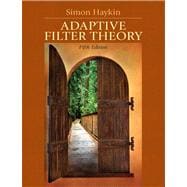Adaptive Filter Theory, 5e, is ideal for courses in Adaptive Filters.
Haykin examines both the mathematical theory behind various linear adaptive filters and the elements of supervised multilayer perceptrons. In its fifth edition, this highly successful book has been updated and refined to stay current with the field and develop concepts in as unified and accessible a manner as possible.








